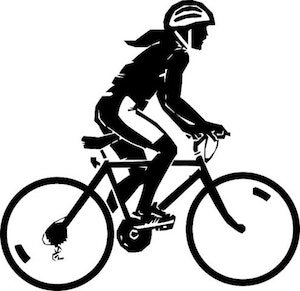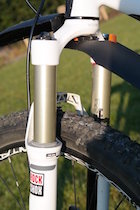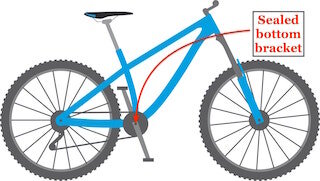“In practice, a narrowest seat can minimize the interference between the thighs and the seat during cycling.”
A bicycle saddle that is too wide causes chafing due to your thighs rubbing against the sides of the seat and reduces pedal efficiency since the saddle interferes with your pedaling motion. Also, aerodynamics is worsened from the increased contact area between your spread-out legs and the increased air resistance.
However, for recreational or leisurely riding, having too wide of a saddle is typically a non-issue and is generally preferred when comfort is prioritized over performance
For performance-based cyclists, there is a trade-off between pedaling dynamics and comfort
Optimal Saddle Width for Performance
Your saddle should be wide enough to support both your ischial tuberosities (or sit bones) plus an additional centimeter on each side (see image below).
Ideal saddle Width & Performance
When performance is your priority, the ideal saddle width is 2 centimeters more than the width of your sit bones:
1 cm of space between your ischial tuberosities and the edge of your saddle for a total of 2 centimeters
Women’s sit bones are 1 cm wider on average than men’s, but the difference within genders is greater than the difference between the sexes
Saddles wider than this will cause pedal inefficiencies and increase aerodynamic drag
Saddles should be comfortable and allow your legs to pedal without interference, and be narrow enough so you can move around, especially if you’re a mountain biker.
Saddle Too Wide
If your saddle is too wide it’s just in the way. This results in a decrement in performance as you will not be able to pedal efficiently and if you ride long enough and hard enough, then you will develop saddle sores and chaffing. Also, when mountain biking, large saddles are more difficult to maneuver around and will become a limiting factor.
Recreational Riding & Saddle Width
If you’re cycling on a cruiser bike with a wide saddle or riding leisurely in a more upright posture, it’s nearly impossible to have a seat that is too wide.
Saddle Width & Contact Area
Keep in mind that the larger the saddle, the more contact area your seat has to spread out your body weight. Your sit bones do NOT have direct contact with the seat surface, because they are covered by muscles and fat tissues. The wider the seat, the more of you that is being supported.
Pressure Distribution of Bicycle Patrol Officers
More Than Just Saddle Width
The above image is from a 2002 study that researched saddle pressure among bicycle cops:
Image on the left: Male sitting in a normal chair
Middle Image: Bicycle Cop seated in upright position on a bicycle saddle
Far right Image: Male is a forward-leaning, aggressive cycling position
Notice how the pressure moves from the buttock area in both the chair and upright seated positions to the perineum as the cyclist leans forward in a “pursuit” position??
Saddle width is hugely important, however, saddle shape, cutout, firmness, and dimensions, all affect how your seat interacts with your body and riding style.
Saddle Not Wide Enough
Having a saddle that is too NARROW is more common and significantly more problematic than having a saddle that is too wide. When your saddle isn’t wide enough to support both of your sit bones, then your body weight is primarily supported by your body parts between the sit bones, which is your perineum.
The labia for females
Penis region for males
Putting pressure on these sensitive areas can cause health problems in the long- term and is uncomfortable in the short-term. Many people that find cycling to be “uncomfortable” need to swap out their saddle as the shape or size is putting pressure on their perineum.
Finding Ideal Saddle Width
The key is finding a saddle that fits your anatomy, matches your riding style, and is comfortable. Your local bike shop has devices that measure your sitting bone and a wide range of saddle widths to accompany your unique body.
(Image Source: Chen 2018)
X-ray scanning is the most effective and accurate method for measuring the distance between your ischial tuberosities (sit bones). However, this isn’t realistic unless your an Olympic or Elite cyclist.
You can get fairly accurate measurements by sitting on a piece of corrugated cardboard or having a good friend/partner do a direct measurement.
Measure the distance between your sit bones
Add 2 cm at the very minimum
Final Thought
“The first rule of saddle fit is that it’s supposed to support your sit bones, not your whole butt.”
A bike saddle is a comprise between comfort, ease of mounting/dismounting, weight, cost, look, feel, comfort, and pedaling dynamics. For 90% of cyclists, it’s nearly impossible to have a seat too wide.
Jesse is the Director of Pedal Chile and lives in La Patagonia. Jesse has a Master of Science in Health and Human Performance and a Bachelor of Science in Kinesiology. Hobbies: Mountain biking, bicycle commuting, reading, snowboarding, researching, and sampling yummy craft beers.
Sources & References for “Can A Bicycle Seat Be Too Wide”
Arthurs-Brennan, Michelle. “How to Choose the Right Saddle for You.” Cycling Weekly, 12 May 2020.
BikeFit. “Sit Bones Width Measurement and Bike Saddle Selection.” BikeFit, 15 Oct. 2019, blog.bikefit.com/sit-bones-width-measurement-and-bike-saddle-selection/.
Chen, Wei-Long, and Fang-Lin Chao. “Novel Structural Design of a Bicycle Saddle to Fulfill Cyclist Physiological Requirements.” Recent Patents on Engineering, vol. 14, 19 Aug. 2020, 10.2174/1872212114999200819154905.
Chen, Yi-Lang. “Predicting External Ischial Tuberosity Width for Both Sexes to Determine Their Bicycle-Seat Sizes.” International Journal of Industrial Ergonomics, vol. 64, Mar. 2018, pp. 118–121, 10.1016/j.ergon.2018.01.008.
Chen, Yi-Lang, and Ping-Jui Yang. “A preliminary study of the measurement of external ischial tuberosity width and its gender differences.” Journal of physical therapy science vol. 28,3 (2016): 820-3. doi:10.1589/jpts.28.820
Christiaans HH, Bremner A. Comfort on bicycles and the validity of a commercial bicycle fitting system. Appl Ergon. 1998;29(3):201-11. doi: 10.1016/s0003-6870(97)00052-5. PMID: 9676337.
Guess, Marsha K et al. “Women's bike seats: a pressing matter for competitive female cyclists.” The journal of sexual medicine vol. 8,11 (2011): 3144-53. doi:10.1111/j.1743-6109.2011.02437.x
Litwinowicz, K., Choroszy, M. & Wróbel, A. Strategies for Reducing the Impact of Cycling on the Perineum in Healthy Males: Systematic Review and Meta-analysis. Sports Med 51, 275–287 (2021). https://doi.org/10.1007/s40279-020-01363-z
Schrader, Steven & Breitenstein, Michael & Clark, John & Lowe, Brian & Turner, Terry. (2002). Nocturnal Penile Tumescence and Rigidity Testing in Bicycling Patrol Officers. Journal of andrology. 23. 927-34. 10.1002/j.1939-4640.2002.tb02352.x.
“The Four and a Half Rules of Road Saddles.” Www.cervelo.com, 15 Sept. 2015, www.cervelo.com/en/the-four-and-a-half-rules-of-road-saddles.
Yeager, Selene. Every Woman’s Guide to Cycling : Everything You Need to Know, from Buying Your First Bike to Winning Your First Race. New York, New American Library, 2008.
















